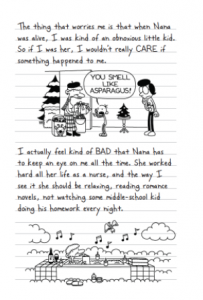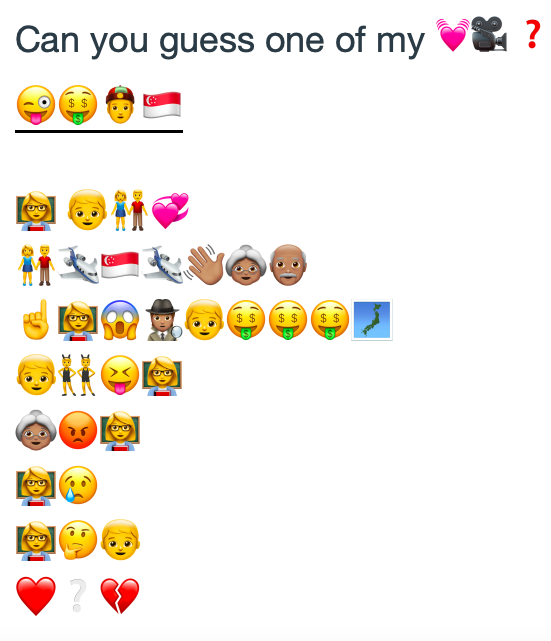This was a fun and insightful assignment. I thought it would be very easy at first, as I often use emojis when I text message. It was surprising to me that it was much more difficult than I expected because I was trying to translate words verbatim into emojis. I started with the title of my favorite movie-not too bad. It helped me to write out the plot in words to start. I thought I could just translate the words into emojis from there, much as how I might do that when translating from English to French text (which I often do when writing to my friends). But this was much more challenging, as I could not find the exact emojis that translated from the words that I was using to describe the movie’s plot. I also struggled with trying to articulate the emojis so that my audience would understand what I meant to say. I wrote, copied, pasted and re-pasted so many times. I also experimented with different emojis and kept substituting for others after re-reading what I had typed to see if it made better sense.
When Bolter (2001) discusses in Chapter 4 how verbal literacy in the medieval society was divided by the elite being a small group of literate people and a much larger group of illiterate people. It had me wondering, does using emojis more than text create a sense of illiteracy? It would seem that our vocabulary would be diminished if we were just to use images and emojis to communicate messages. I found that when I was trying to create and find the appropriate emojis to describe what I wanted to communicate, I had to exclude, change and simplify so many words that I wanted to use to describe my movie’s plot as there were no emojis that I could really use in place of certain words. Such as, jealous, socialite” and Asians. I did struggle with finding an emoji to translate into the word, “Asian.” I was surprise to find a person emoji wearing a “gua pi mao” (which is an type of Chinese skullcap). I perused through a few more and noticed that this particular emoji keyboard was not very diverse. It had me wondering about what this type of communication and literacy development might do to our students in terms of their views on diversity and being politically correct. If many young people are using emojis more and more to communicate (my students do a lot when chatting on many platforms) and they only know what they are exposed to (more and more), should emoji keyboards be more diversified and explained? Could this type of literacy in text influence students opinions on cultures, specifically?
I definitely agree with Bolter (2001) as he mentions how prose today is focusing on being more visual and sensuous including some academic texts. I certainly have observed this with novels that my students are reading in class. The most sought after books are graphic novels, such as The Diary of a Wimpy Kid series where there are constant (interruptions of) images and comic-like animations between the text. The visual images dominate the page and dilute the text furthermore, taking its place as a picture on the printed page (Bolter, 2001). See sample page of this graphic novel below.

Image taken from “The Diary of a Wimpy Kid” novel series by Jeff Kinney
What does this mean for our students in terms of their literacy? If novels are becoming more graphic and animated, isn’t that almost like inserting a giant emoji in place of some of the text? What might happen to this generations vocabulary and literacy skills?
References
Bolter, J.D. (2001). Writing Space: Computers, hypertext, and the remediation of print. Mahway, NJ: Lawrence Erlbaum Associates, pp. 47-76.
Zaltzman, H. (Host). (2019, July 13). New rules (No. 102) [Audio podcast episode]. In The Allusionist. https://www.theallusionist.org/allusionist/new-rules
